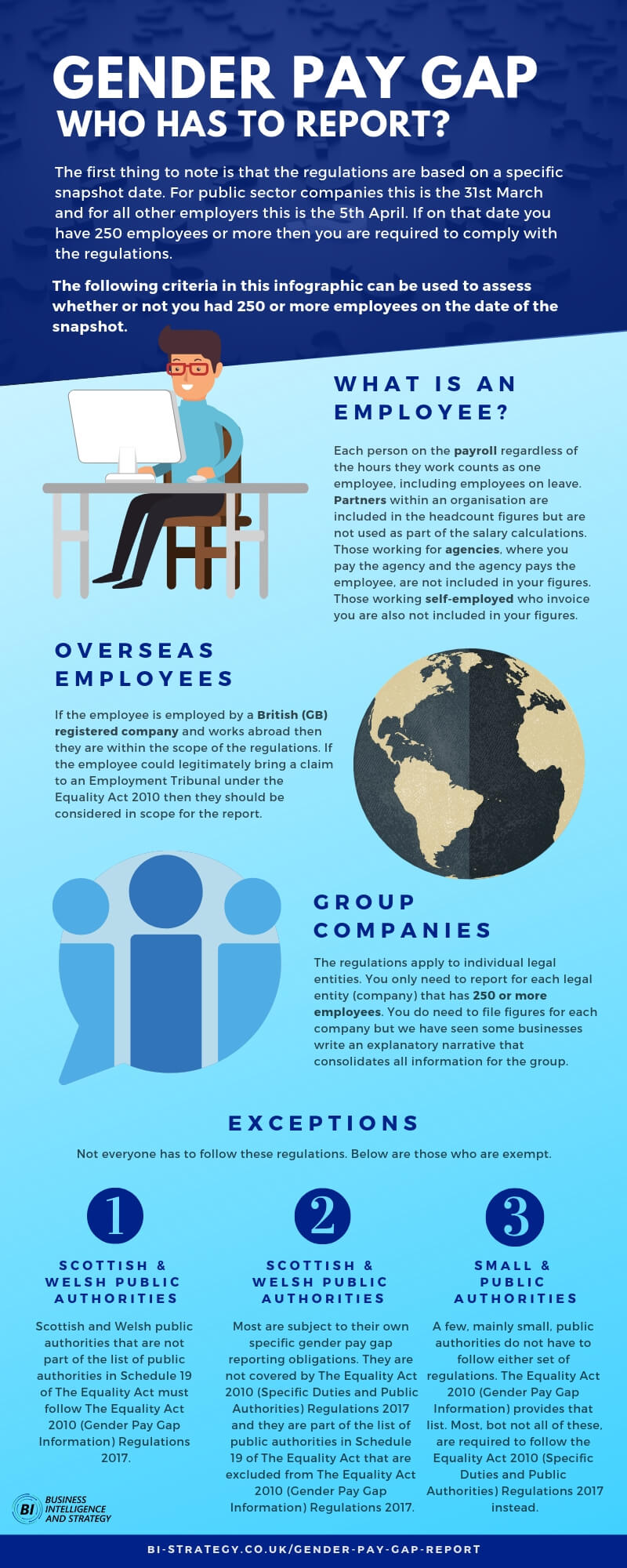
All ‘relevant employers’ must report their gender pay gap information. Companies who are deemed a ‘relevant employer’ have 250 or more employees and are based in England, Scotland or Wales.
Finding out whether you need to submit a report for the gender pay gap can be challenging particularly if you have a significant number of temporary, agency or overseas workers or your workforce numbers vary above and below the 250 mark.
If you are you unclear about whether your company is a ‘relevant employer’ or not this article is for you, as we will look into the following topics:
- Who has to report gender pay gap information?
- What is an ‘employee’?
- Overseas/international employees
- Group companies
- Exceptions
- How do I work out if I have more than 250 employees?
- Can I report on a voluntary basis?
- How can a business tell the government their out of scope?
- Where can I find gender pay gap information?
If you are still unclear after you have finished reading, it’s best to seek professional are legal advice.
Who has to report gender pay gap information?
The first thing to note is that the regulations are based on a specific snapshot date. For public sector companies this is the 31st March and for all other employers this is the 5th April. If on that date you have 250 employees or more (as defined below) then you are required to comply with the regulations.
If you have less than 250 employees you can still submit voluntarily and in doing so you could experience some of the benefits associated with Gender Pay Gap reporting.
The following criteria can be used to assess whether or not you had 250 or more employees on the date of the snapshot:
What is an ‘employee’?
You only need to report based on the people that you employ directly. This includes full and part time employees and each employee that forms part of a job share. Each person on the payroll regardless of the hours they work counts as one employee. Remember to also include any employees on leave.
Partners within an organisation are included in the headcount figures (to assess if you have 250) but are not used as part of the salary calculations as they are generally not ‘paid’ but take a dividend or profit-share.
Those working for agencies, where you pay the agency and the agency pays the employee, are not included in your figures. Those working self-employed who invoice you are also not included in your figures.
Overseas/International Employees
If the employee is employed by a British (GB) registered company and works abroad then they are within the scope of the regulations. If the employee could legitimately bring a claim to an Employment Tribunal under the Equality Act 2010 then they should be considered in scope for the report.
As a guideline an employee should be included if they meet one or more of the following:
- Have a contract subject to GB legislation
- Have their home in GB and have UK tax legislation apply to their employment
If you are unsure in any particular cases then you should consider seeking professional advice starting with ACAS.
Group companies
The regulations apply to individual legal entities. This means that even though as a group of companies you may have a total of more than 250 employees you only need to report for each legal entity (company) that has 250 or more employees. You do need to file figures for each company but we have seen some businesses write an explanatory narrative that consolidates all information for the group.
Exceptions
The ACAS document ‘Managing Gender Pay Gap Reporting’ states the following exceptions:
- A few, mainly small, public authorities do not have to follow either set of regulations. The Equality Act 2010 provides a list of public authorities in Schedule 19 that are excluded from The Equality Act 2010 (Gender Pay Gap Information) Regulations 2017. Most, but not all of these, are required to follow the Equality Act 2010 (Specific Duties and Public Authorities) Regulations 2017 instead (they are listed under Schedule 2 of the regulations).
- Most Scottish and Welsh public authorities are subject to their own specific gender pay gap reporting obligations. They are not covered by The Equality Act 2010 (Specific Duties and Public Authorities) Regulations 2017 and they are part of the list of public authorities in Schedule 19 of The Equality Act that are excluded from The Equality Act 2010 (Gender Pay Gap Information) Regulations 2017.
- Scottish and Welsh public authorities that are not part of the list of public authorities in Schedule 19 of The Equality Act must follow The Equality Act 2010 (Gender Pay Gap Information) Regulations 2017.

So now you know the criteria for working out whether or not you had 250 or more employees on the date of the snapshot, we’ll move on to answer some common frequently asked questions related to who has to report gender pay gap.
How do I work out if I have 250 or more employees?
The exact definition of ‘employee’ for gender pay gap reporting includes:
- Those who have an employment contract with your company
- Both workers and agency workers who have a contract to do work/provide services for your company
- Those who are self employed and have personally performed the work for your company
- Partners in traditional partnerships or LLPs if they have a contract personally to carry out work for the company, but they don’t have to be included in the calculations.
Can I report on a voluntarily basis?
If you have less than 250 employees you are not obliged to report gender pay gap information, however, there’s nothing stopping you publishing and reporting data on a voluntarily basis. There has even been evidence to suggest that there is a correlation between gender pay gap reporting and business success and growth.
How can a business tell the government their out of scope?
The Government Equalities Office will be sending letter to all employers who are required to report gender pay gap information. Businesses who have received this letter, but the regulation do not apply to you this reporting year, you can tell the government they are not in scope by emailing them at gpg.reporting@geo.gov.uk.
Where can I find gender pay gap information?
The best initial source for your list of employees on the date of the snapshot will be your payroll system. You may also have to add in any relevant Partners.
Need help with extracting data?
If you need help to extract the relevant information from your organisation’s data then contact us. Our experienced data experts can help to gather and consolidate the figures you need not only this year but for your future reporting requirements.
Useful resources
- ACAS – If you are involved in an employment dispute or are seeking information on employment rights and rules, you can contact the Advisory, Conciliation and Arbitration Service (ACAS). Freephone: 0300 123 1100 (8am to 8pm Monday to Friday and 9am to 1pm Saturday).
- Managing Gender Pay Gap Reporting
- Gender Pay Gap Reporting Challenges


